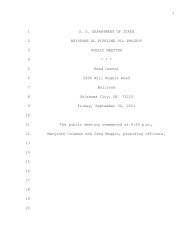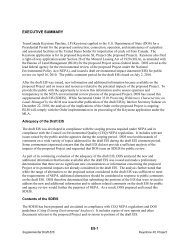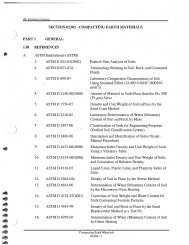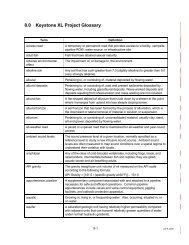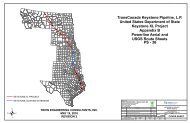Draft Supplemental Environmental Impact Statement<strong>Keystone</strong> <strong>XL</strong> <strong>Project</strong>Oil spills on <strong>the</strong> ground surface and some releases below grade potentially could ignite. PHMSAdata for onshore oil and hazardous material <strong>pipeline</strong>s indicate that only 6 <strong>of</strong> 2,706 incidents (0.2percent) that occurred from 1990 through 2009 were attributed to “fire/explosion as a primarycause.” Six out <strong>of</strong> 3,033 incidents were reported as due to <strong>the</strong> referenced cause. Two out <strong>of</strong> 1,360crude oil incidents were reported as due to <strong>the</strong> reference cause.A search <strong>of</strong> <strong>the</strong> internet for reports <strong>of</strong> crude oil <strong>pipeline</strong> explosions suggests that 1) <strong>the</strong>re are veryfew if any explosions in crude oil <strong>pipeline</strong> operation that were <strong>the</strong> result <strong>of</strong> a failure <strong>of</strong> <strong>the</strong><strong>pipeline</strong> as a primary cause, and 2) <strong>the</strong> very few that have occurred are attributable to explosionsin ancillary facilities or errors in operations unassociated with crude oil transportation. Forexample, <strong>the</strong> recent explosion and fire in <strong>the</strong> crude oil <strong>pipeline</strong>/storage tank area in Dalian,China, occurred as a result <strong>of</strong> an improper desulfurization operation; <strong>the</strong> primary cause was not<strong>the</strong> transport <strong>of</strong> crude oil in <strong>the</strong> <strong>pipeline</strong>.An accidental crude oil spill from <strong>the</strong> <strong>pipeline</strong> or at a pump station would likely result in somehydrocarbon vapors, but <strong>the</strong>y would not be in confined spaces and <strong>the</strong>refore would be unlikely toexplode. A fire associated with a release from a crude oil <strong>pipeline</strong> is relatively rare. In <strong>the</strong> event<strong>of</strong> a fire, local emergency responders would execute <strong>the</strong> roles listed above and more specificallyin <strong>the</strong> PSRP and <strong>the</strong> ERP, and firefighters would take actions to prevent <strong>the</strong> crude oil fire fromspreading to residential areas.RemediationCorrective remedial actions would be dictated by federal, state, and local regulations andenforced by <strong>the</strong> <strong>US</strong>EPA, Office <strong>of</strong> Pipeline Safety, and appropriate state and/or local agencies.Required remedial actions may be large or small, dependent upon a number <strong>of</strong> factors includingstate mandated remedial cleanup levels, potential effects to sensitive receptors, <strong>the</strong> volume andextent <strong>of</strong> <strong>the</strong> contamination, whe<strong>the</strong>r or not <strong>the</strong>re is a violation <strong>of</strong> water quality standards, and <strong>the</strong>magnitude <strong>of</strong> adverse impacts caused by remedial activities. A large remediation action mayinclude <strong>the</strong> excavation and removal <strong>of</strong> contaminated soil or could involve allowing <strong>the</strong>contaminated soil to recover through natural attenuation or environmental fate processes such asevaporation and biodegradation.If, during construction, tanks or contamination are found, <strong>the</strong>y would be managed according t<strong>of</strong>ederal, state, and/or local regulations. Fur<strong>the</strong>r, <strong>Keystone</strong> would make individuals available whoare trained in identifying and disposing <strong>of</strong> hazardous materials during construction.If <strong>the</strong>re is an accidental release from <strong>the</strong> proposed <strong>Project</strong>, <strong>Keystone</strong> would implement <strong>the</strong>remedial measures necessary to meet <strong>the</strong> federal, state, and local standards that are designed toensure protection <strong>of</strong> human health and environmental quality. Additional information onremediation is presented in Section 4.13, Potential Releases.<strong>2.1</strong>.12 Connected ActionsThere are three actions that are separate from <strong>the</strong> proposed <strong>Project</strong> that are not part <strong>of</strong> <strong>the</strong>Presidential Permit application submitted by <strong>Keystone</strong>, but are being reviewed as connected<strong>Project</strong> Description <strong>2.1</strong>-74 March 2013
Draft Supplemental Environmental Impact Statement<strong>Keystone</strong> <strong>XL</strong> <strong>Project</strong>actions 6 pursuant to NEPA. The three connected actions are <strong>the</strong> Bakken Marketlink <strong>Project</strong>, <strong>the</strong>Big Bend to Witten 230-kilovolt (kV) electric transmission line, and electric distribution linesand substations associated with <strong>the</strong> proposed pump stations.Preliminary information on <strong>the</strong> design, construction, and operation <strong>of</strong> <strong>the</strong>se projects is presentedbelow. Although <strong>the</strong> permit applications for <strong>the</strong>se projects would be reviewed and acted on byo<strong>the</strong>r agencies, <strong>the</strong> potential impacts <strong>of</strong> <strong>the</strong>se projects have been analyzed in <strong>the</strong> SupplementalEIS based on currently available information and are addressed within each resource assessed inChapter 4, Environmental Consequences. However, in some cases only limited information wasavailable on <strong>the</strong> design, construction, and operation <strong>of</strong> <strong>the</strong> projects. The reviews <strong>of</strong> permitapplications by o<strong>the</strong>r agencies would include more detailed environmental reviews <strong>of</strong> <strong>the</strong>connected actions.<strong>2.1</strong>.1<strong>2.1</strong> Bakken Marketlink <strong>Project</strong><strong>Keystone</strong> Marketlink, LLC, a wholly owned subsidiary <strong>of</strong> TransCanada Pipelines Limited, isproposing to construct and operate <strong>the</strong> Bakken Marketlink <strong>Project</strong>. It would include constructionand operation <strong>of</strong> facilities within <strong>the</strong> boundaries <strong>of</strong> <strong>the</strong> proposed <strong>Keystone</strong> <strong>XL</strong> Cushing tankfarm. This location is adjacent to <strong>the</strong> Cushing Oil Terminal, a key <strong>pipeline</strong> transportation andcrude oil storage hub with over 50 million barrels <strong>of</strong> storage capacity. Crude oil in <strong>the</strong> BakkenMarketlink storage tanks at <strong>the</strong> Cushing tank farm would ei<strong>the</strong>r be pumped to <strong>the</strong> <strong>Keystone</strong> <strong>XL</strong><strong>pipeline</strong> or to o<strong>the</strong>r <strong>pipeline</strong>s and tank farms near Cushing. The Cushing tank farm would be nearmany <strong>pipeline</strong>s, storage facilities, and refineries; <strong>the</strong> Cushing area is a major crude oil marketing,refining, and <strong>pipeline</strong> hub that provides shippers with many delivery options and market access.The project would include construction <strong>of</strong> facilities to provide crude oil transportation servicefrom near Baker, Montana, to <strong>the</strong> <strong>Keystone</strong> Cushing Expansion in Kansas. <strong>Keystone</strong> Marketlink,LLC obtained commitments for transport <strong>of</strong> approximately 65,000 barrels per day (bpd) <strong>of</strong> crudeoil through <strong>the</strong> Marketlink <strong>Project</strong>. The Bakken Marketlink <strong>Project</strong> could deliver up to 100,000bpd to <strong>the</strong> proposed <strong>Project</strong> depending on ultimate shipper commitments.The project would consist <strong>of</strong> piping, booster pumps, meter manifolds, and one 250,000-barreltank that would be used to accumulate crude from connecting third-party <strong>pipeline</strong>s and terminalsand a 100,000-barrel tank that would be used for operational purposes (see Figure <strong>2.1</strong>.12-1).Tanks at both locations will be external floating ro<strong>of</strong> tanks. At Cushing <strong>the</strong>re will be crude oilbooster pumps located at <strong>the</strong> facility for transfer <strong>of</strong> <strong>the</strong> crude oil from <strong>the</strong> <strong>pipeline</strong> to <strong>the</strong> crude oilstorage tanks. All booster pumps are electrically driven. Preliminary design engineering indicatesthat no combustion equipment (e.g., emergency generator engines) or o<strong>the</strong>r add-on controldevices (e.g., emergency flares or vapor recovery units) would be constructed at <strong>the</strong> facility. Thefacilities would also include a proposed <strong>pipeline</strong> that would be approximately 5 miles in length,originating south <strong>of</strong> pump station 14 at a third party tank farm in Fallon County, and extending to<strong>the</strong> <strong>Keystone</strong> Bakken Terminal. TransCanada Pipelines Limited Bakken held introductorymeetings with State and local permitting agencies in 2011, and also held a meeting forpotentially affected landowners along <strong>the</strong> route. Adjustments in <strong>the</strong> alignment are possible as aresult <strong>of</strong> civil surveys, fur<strong>the</strong>r landowner discussions, and permitting. The proposed in servicedate for <strong>the</strong> Bakken Marketlink <strong>Project</strong> is projected to be <strong>the</strong> first or second quarter <strong>of</strong> 2015.6Additional relevant information related to connected actions is pending and will be included in this review as part<strong>of</strong> <strong>the</strong> Final Supplemental EIS.<strong>Project</strong> Description <strong>2.1</strong>-75 March 2013



